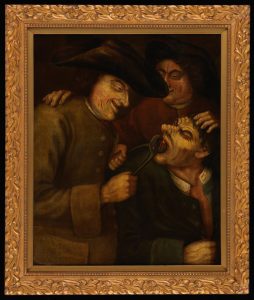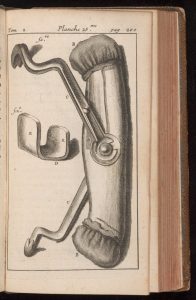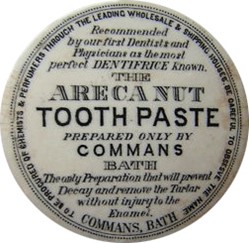Toothache is usually extremely painful. Nowadays a visit to the dentist can provide relief and save the tooth. Three hundred years ago someone with toothache would have gone to their local blacksmith or an itinerant “tooth-puller” to have the offending tooth extracted. There were no anaesthetics available and very often the operator broke off part of their jaw as well as their tooth! If they survived the pain and discomfort of that, they would expect to bleed profusely and the injured gum might prevent them from eating any solids for several weeks. In the worst outcome, they might have died from complications of infection and haemorrhage.
Blacksmiths often pulled out teeth because they were able to make their own instruments for tooth pulling. The first instrument designed for tooth extraction was called a pelican because it resembled the shape of the bird’s beak. Pelicans were around as early as the 14th century. They provided a way of levering the tooth from the gum although the tooth was sometimes snapped off leaving the root stump in place.
In the eighteenth century the pelican was displaced by the dental key which, if used skilfully, was less likely to result in serious injury to the gums and neighbouring teeth. Unfortunately, there were few skilled tooth pullers available and injuries were still common. Since the end of the nineteenth century extractions have been performed using specially shaped forceps.
Dental surgeons didn’t appear as a specialised branch of medicine until the mid-eighteenth century and France was the first country to train dentists as professionals. Paris became the leading centre for dental surgery. The first detailed book on the subject. Le Chirurgien Dentiste was published in 1728 by Pierre Fauchard, a French surgeon. His book was soon translated into German but the first English translation did not appear until 1946! Fauchard’s book described how to make false teeth from ivory and bone and even dental implants. He was a pioneer of orthodontics using dental braces and filings for decayed teeth. He also recognised the danger sugar posed to the teeth.


Some of earliest dental surgeons in England came from abroad, touring around provincial cities like Bath and Bristol, advertising their presence in the local press. Some of these early dentists ultimately set up permanent practice in Bath. Bartholomew Ruspini from Italy practised in the city for several years before moving to London in 1766. Joseph Sigmond, a German citizen, moved to Bath from Exeter and remained in the city until his death in 1832. He is buried in the Jewish cemetery in Combe Down.
Foreign origins carried a certain prestige and many English dentists claimed to have worked or trained abroad. Between 1744 and 1800, 35 different dentists worked in Bath either resident or visiting. Of these around half were French, German or Italian. Most dental practitioners ranked with ordinary tradesmen but foreigners or those who had trained abroad acquired a celebrity status. Some like Joseph Sigmond earned large sums not just from dental work but also from patenting tooth cleaning powders and tinctures. Other wealthy “celebrity” dentists included Ruspini who spent much of his fortune on philanthropy, Lemaire who was surgeon dentist to the exiled Duc d’ Artois and Dubois de Clémant who visited Bath from 1795 and specialised in making porcelain dentures.

Some of the eighteenth-century dentists in Bath continued a dental dynasty for several generations. John Goldstone who had a practice in Green Street in 1765 and advertised teeth scaling, tinctures for scurvy of the gums and an opiate dentifrice for preserving, fastening and beautifying the teeth had both a son and a grandson who carried on the practice. Other resident dentists like Foy, Hemet Hart and Charlton also had London practices. In 1790, George Shew, another visiting dentist offered enamelled ivory teeth which were odourless and guaranteed to retain colour for 20 years. Shew charged between 16 and 30 guineas for his dentures.
Tooth decay was thought to be caused by tooth worms. Mechanical dental drills were not invented until the 19th century so dentists used picks to clear out the carious material from the tooth. They filled the hole with either gold, lead or various forms of paste, the composition of which was kept secret. Amalgam of mercury and silver was first used in the early nineteenth century and remained the standard way of filling cavities until the 1980s with the advent of white composite resin fillings which can be solidified using a blue light. Since then, these blue “curing” lights have improved both in their efficiency and portability and curing takes place in a few seconds.
Although Pierre Fauchard (see above) described a bow drill in his book, the first mechanical dental drill was invented in 1863 by George Fellowes Harrington, a dentist working in Portsmouth. It was driven by clockwork and had to be rewound every two minutes. Not surprisingly, it had limited appeal and in 1872 a far more practical drill was invented by an American dentist James Morrison which was capable of 2000 revolutions per minute and operated by a treadle mechanism similar to a sewing machine. Since then, electric motors have displaced foot power and further developments led to high-speed drills. Driven by compressed air, modern turbine drills can rotate in excess of 250,000 r.p.m.

With brush and paste – dental hygiene
Scurvy was once a common condition before the discovery that fresh fruit could prevent it. Classic symptoms are a tendency for the gums to bleed and the teeth to loosen. But these symptoms were just as often due to poor dental hygiene causing the gum disease known as gingivitis. As well as bleeding, the gums were sore and the breath foetid. The novelist Tobias Smollett who worked as a doctor in Bath for a while commented on the stink of foul breath emanating from the crowds in the Assembly rooms during the eighteenth century. Dental hygiene was often neglected and poorly understood. Social distancing was just as much needed then as it in 2021, but for a different reason.
Although toothbrushes were used by some cultures many centuries ago, their common use in the UK only started in the eighteenth century. Before that, teeth were cleaned with a cloth. Tobias Venner, a doctor practising in Bath wrote in 1638: “Let the mouth be well cleansed with cold water, and the teeth rubbed thereupon with a course dry cloth. It will be the better if a little vinegar or white wine be sometimes added to the water, and the gums and teeth rubbed with a sage leaf or two dipped therein, or washed and cleansed with the infusion aforesaid, and the teeth afterwards rubbed with a course dry cloth, for this [will] purify the breath, and preserve the teeth from corruption”
The eighteenth century saw the advent of the patent dentifrices, often using secret ingredients. These could be made up as powders, pastes or lotions. Mouthwashes were also popular. In the nineteenth century, toothpaste was sold in pots. A Bath pharmacist, R. D. Commans manufactured tooth paste containing areca nut, a popular additive which not only gave the paste a distinctive taste but may have helped to inhibit bacteria associated with tooth decay. Some cultural groups nowadays chew areca nut but because it has been associated with oral cancer it is no longer recommended as a toothpaste constituent. Modern toothpaste is dispensed in collapsible metal or plastic tubes. The early tubes were made of lead.
Article By Dr Roger Rolls
